Not all organic traffic is created equally.
Often, organic search is criticized for taking credit for branded traffic that other marketing channels influenced.
Since SEO is already an often misunderstood channel, it’s important to have a clear strategy for the content and audience you’re targeting and report accordingly.
This post discusses the difference between branded and non-branded keywords and traffic, and what they mean for your SEO strategy.
After all, a brand search query may have intent to visit your website, where non-branded keywords have the opportunity to introduce or influence a user to select your website.
Side note: You can still influence branded traffic through organic search content to drive more demand to branded queries. More on that later…
Table of Contents:
- What are Branded Keywords?
- Why is Optimizing for Branded Keywords Important
- What are Non-Brand Keywords?
- Why is Optimizing for Non-Branded Keywords Important?
- How Much Branded and Non-Branded Traffic Should You Have?
- How to Segment Branded and Non-Branded Keywords
What are Branded Keywords?
Branded keywords are search terms that include the name of your brand.
The search query “Apple iPhone” or “Nike shoes” are both branded keywords because they explicitly include the brand name.
Traffic from branded keywords tends to be more transactional. The user is usually closer to the bottom of the funnel and looking to make a specific purchase.
Why is Optimizing for Branded Keywords Important
Below, we'll dive into five different reasons why SEOs should optimize their website for branded keywords.
1. To Optimize for Other Branded Queries Your Website Sells
This also applies to queries that include the brand name and words like “reviews” or “discounts”.
Since branded keywords signal a high intent to purchase and convert, and usually result in a higher CTR, it’s important to optimize for all variations of the branded query.
Branded queries like “lulu leggings” and “lulu belt bag”, for example, are probably obvious and Lululemon likely ranks high for these queries.
Taking a look at lululemon.com in the Research Grid shows that the Lululemon website relies on branded traffic:
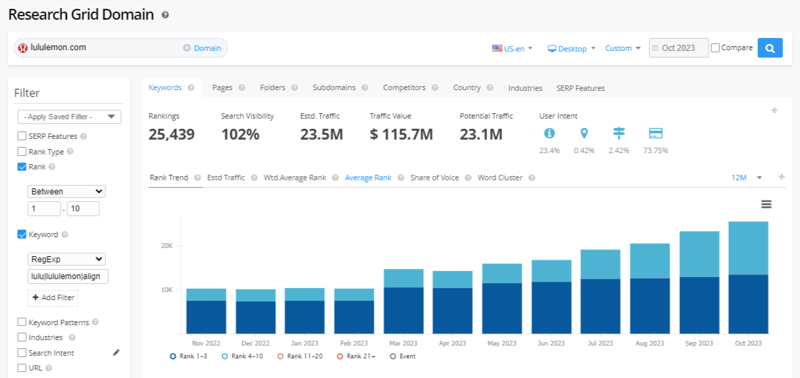 (Rankings between positions 1-10 that include branded keywords.)
(Rankings between positions 1-10 that include branded keywords.)
More than 50% of their online traffic results from keywords that include their brand.
But, queries like “lulu reviews” and “lulu discounts” have other websites that rank for these terms.
Companies likely don't have visibility into all of these variations of brand search queries without the help of the SEO team.
Here’s a real-life example of this with H&M — where they don’t even rank above the first fold!
Contrast this to Dick’s Sporting Goods, which ranks in the first position for branded queries related to coupons:
2. To Invest in Non-Transactional Branded Queries
It’s also important to be mindful of non-transactional branded keywords, like “Lulu customer service.”
These queries allow you to own that conversation in search results, becoming the authoritative voice on questions about your brand and offering valuable insights to customers.
For example, many airlines don't rank in the top spot for inquiries about their own flight rules, missing the opportunity to guide customers and reinforce their brand authority.
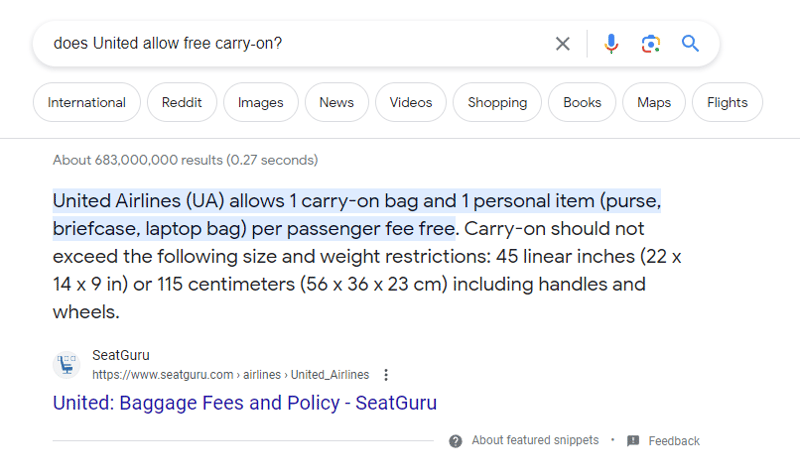
3. To Create a Positive Online Search Experience
Optimizing for branded keywords also creates a positive user experience online.
If an investment is made in offline marketing or other digital channels without optimizing for the online search experience, this is a missed opportunity to capture the online audience within the search.
After all, you want to optimize your investment in your paid channels to optimize your organic visibility on the SERP.
Here’s another example of what happens when you don’t optimize for branded keywords.
Black & Decker sells a portable washing machine, but look who is winning for that Black & Decker keyword: Amazon!
Brands that leverage other digital and offline marketing channels to build their brand like Lululemon drive a lot of branded keyword traffic.
Albeit easier for Lululemon because other retailers don’t sell their products, this still demonstrates the importance of SEO to capture those branded queries’ traffic and conversions.
4. To Dominate the SERP with Paid and Organic
Boosting SERP visibility requires a smart mix of organic and paid strategies. Optimizing for key branded terms enables the paid team to save the money they would have spent on those keywords in paid ads.
When SEO and paid teams work together, they're also able to dominate search results more effectively. This united front not only strengthens brand presence and visibility but also drives up engagement and conversions.
5. To Monitor the Health of Your Brand
Finally, monitoring branded keywords can shine a light on the overall health of your brand. For example, you can analyze traffic and search volume trends to see if demand has risen or fallen year-over-year.
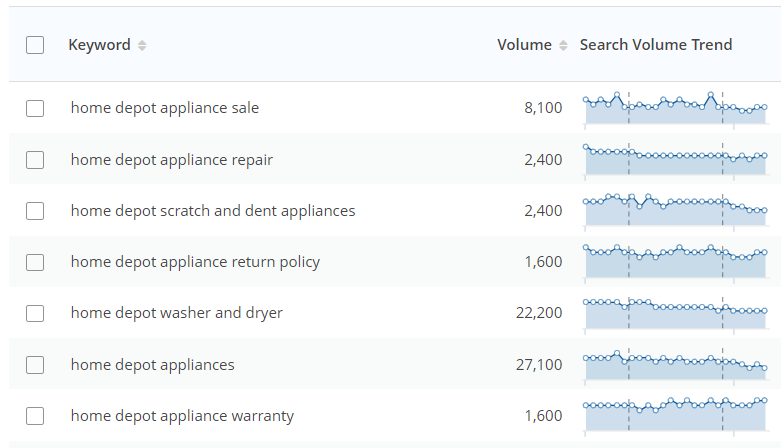
What are Non-Brand Keywords?
Non-branded keywords are search queries that don’t mention your brand. Most likely, they include the name of a generic product, like “running shoes.”
However, sometimes "branded keywords" that aren't your brand are still important to optimize for.
For example, a department store that sells multiple clothing brands would want to optimize for terms that include brand names such as “Nike shoes” or “levi’s jeans.”
Even though these are "branded" keywords, they would still fall within your site's nonbranded traffic. Meaning, you can still attract users to your website to buy Nike shoes or Levi's jeans if you carry those brands.
Traffic from non-branded keywords tends to be more informational. The user is still doing research into various types of products and services.
Recommended Reading: Using Keyword Mapping to Visualize the Buyer Journey and Improve Your SEO
Why is Optimizing for Non-Branded Keywords Important?
Non-branded keywords are usually a critical part of your website's traffic. Most sites drive far more traffic from non-brand keywords than branded keywords.
Non-brand terms can be great to go after because it means the audience is still researching and wants to understand what products and services are available. This can be a great way to expose your brand to the user.
However, non-brand keywords also mean more competition because the searcher is casting such a wide net. This is an opportunity to capitalize on!
Lululemon has much fewer non-branded keywords ranking.
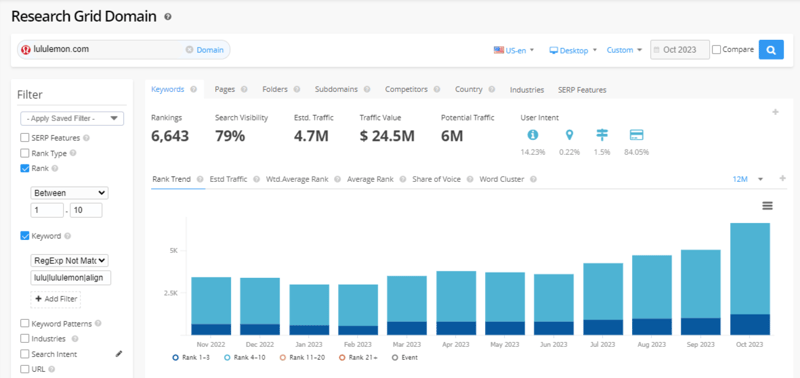
Athleta, on the other hand, does a great job of ranking for non-brand keywords.
Here is their total domain performance:
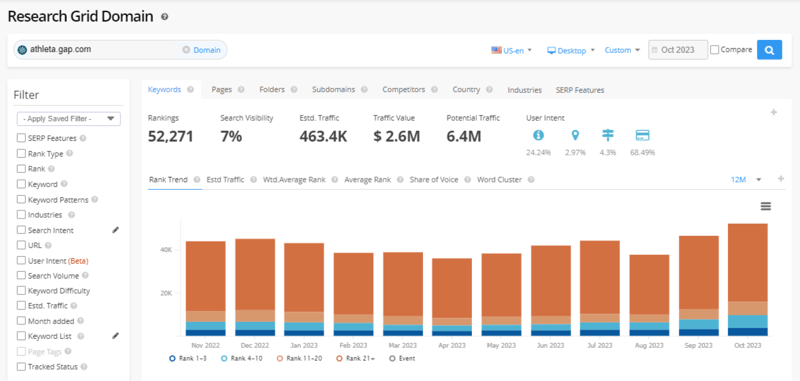
They have about 52,000 ranking keywords.
Here’s where it gets interesting. Let’s filter out all brand keywords (i.e. Athleta and Gap).
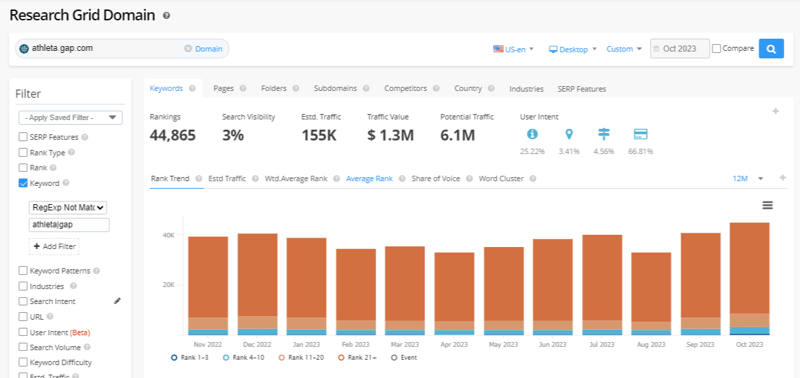
Even without the brand term, Athleta still ranks for about 44,000 keywords.
They understand that optimizing for non-brand keywords is important because you can introduce new users to your website and brand who don’t necessarily have the intent to purchase that day.
You’re creating touchpoints between you and your future customers.
It’s helpful to target non-branded keywords to build visibility. That way, you’re working to increase the amount of branded search queries, which in time will lead to more branded traffic.
How Much Branded and Non-Branded Traffic Should You Have?
Your knowledge of your business and overall marketing strategy will help you determine how to compile your keyword portfolio.
The decision will come down to things like overall company objectives, and what products you sell.
Recommended Reading: Create the Best Keyword Portfolio With This Acronym
How to Segment Branded and Non-Branded Keywords
Keeping your branded and non-branded keywords and traffic organized can help you determine what needs to be prioritized.
The customizable search intent filter in seoClarity lets you specify parameters for categorizing queries into applicable categories. These nested filters can be as detailed as you need them to be to segment your keywords.
Recommended Reading: SEO Segmentation to Scale For SEO Success
For example, if you wanted to create a non-brand filter, you could indicate that by using the "does not contain" <brand name> and any variations. Here is how that would look in the platform.
(Filtering out branded keywords in seoClarity.)
Once you’ve set up the filter, you can slice and dice your data to narrow in on the keywords and traffic that matches those parameters. This can be used throughout the platform too in places like Rank Intelligence.
This way, you can use the search intent filter to see where most of their clicks are coming from.
(Filter by search intent to see where your traffic comes from.)
For a direct comparison between brand and non-brand, switch to the “By Search Intent” tab in Search Analytics to see a trended view of clicks, impressions, CTR, and weighted average position categorized by intent.
(Compare the performance of brand and non-brand keywords in a single view.)
This view can be added as a widget on your seoClarity dashboard for easier reporting and custom alerts.
Conclusion
The ability to segment out branded and non-branded keywords (and their respective performance) lets you get a better idea of what the best approach will be for your business.




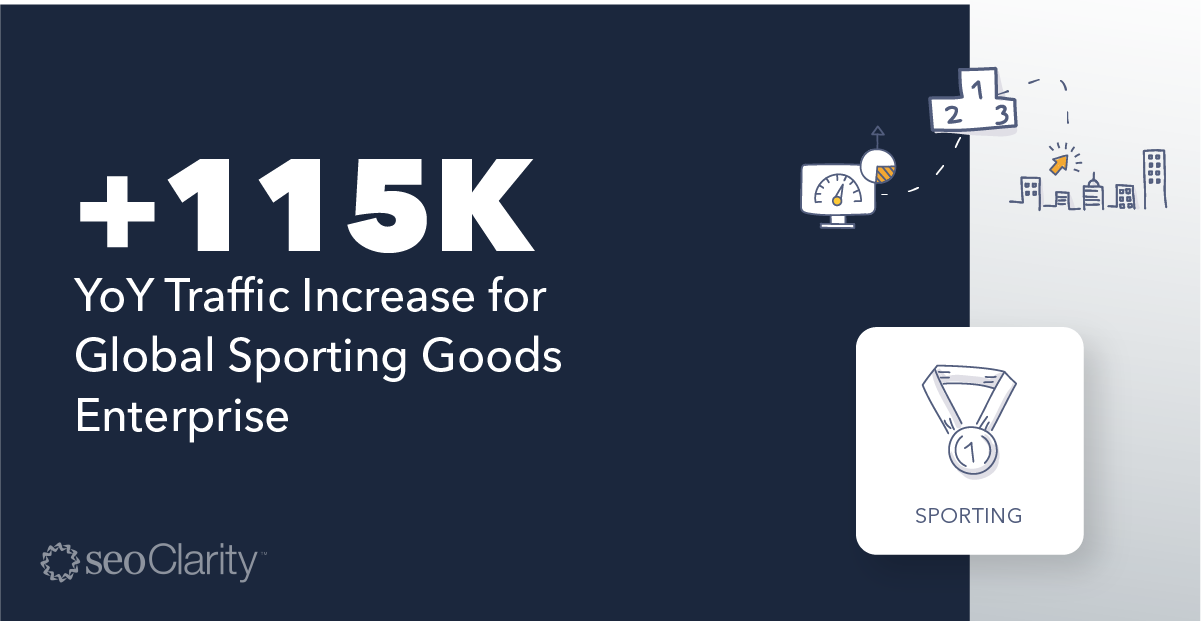
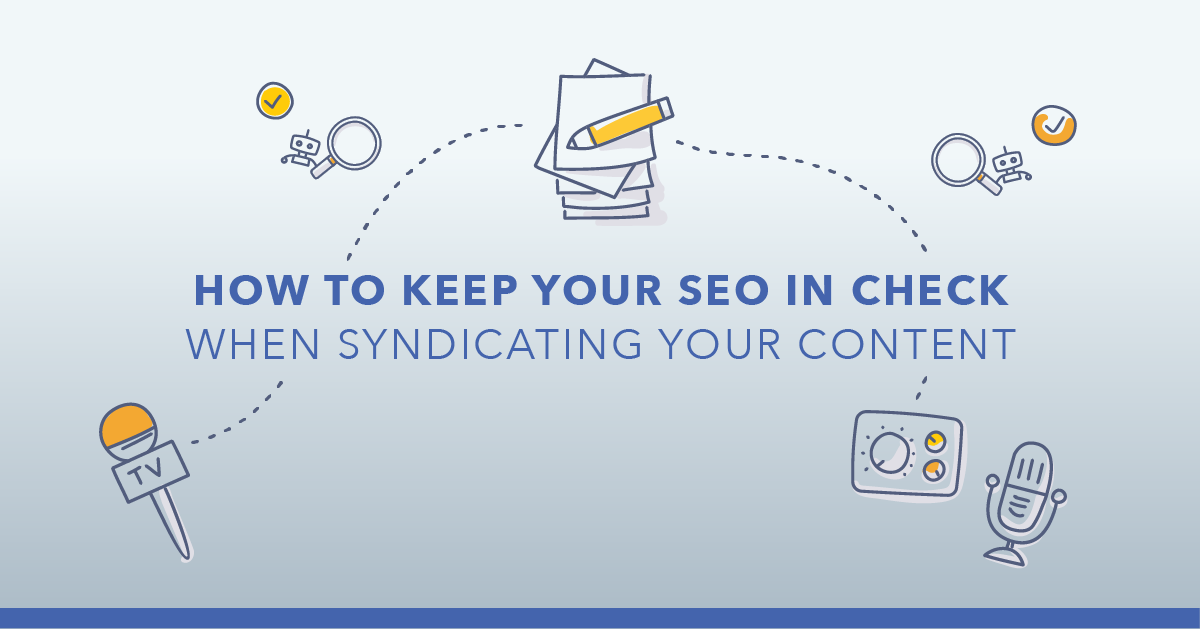

Comments
Currently, there are no comments. Be the first to post one!